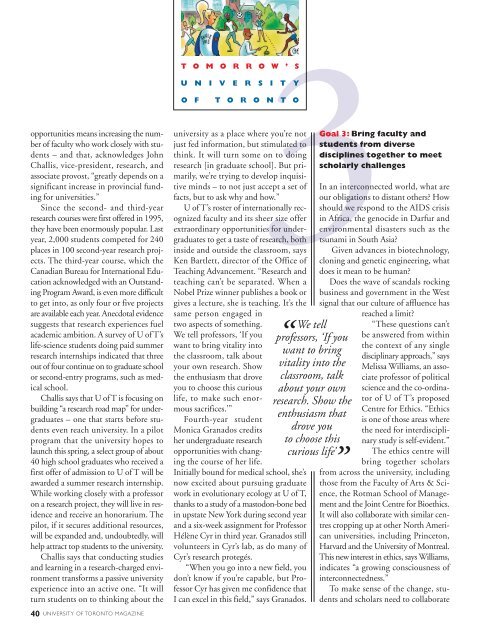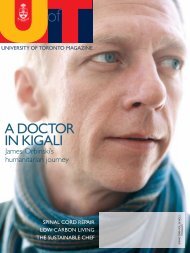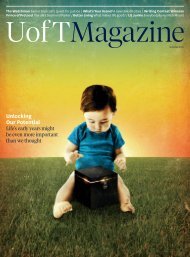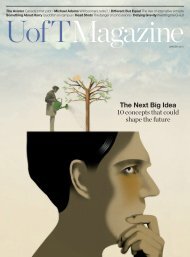Create successful ePaper yourself
Turn your PDF publications into a flip-book with our unique Google optimized e-Paper software.
34-38,40-44 3/2/05 5:<strong>39</strong> AM Page 40opportunities means increasing the number<strong>of</strong> faculty who work closely with students– and that, acknowledges JohnChallis, vice-president, research, andassociate provost, “greatly depends on asignificant increase in provincial fundingfor universities.”Since the second- and third-yearresearch courses were first <strong>of</strong>fered in 1995,they have been enormously popular. Lastyear, 2,000 students competed for 240places in 100 second-year research projects.The third-year course, which theCanadian Bureau for International Educationacknowledged with an OutstandingProgram Award, is even more difficultto get into, as only four or five projectsare available each year. Anecdotal evidencesuggests that research experiences fuelacademic ambition. A survey <strong>of</strong> U <strong>of</strong> T’slife-science students doing paid summerresearch internships indicated that threeout <strong>of</strong> four continue on to graduate schoolor second-entry programs, such as medicalschool.Challis says that U <strong>of</strong> T is focusing onbuilding “a research road map” for undergraduates– one that starts before studentseven reach university. In a pilotprogram that the university hopes tolaunch this spring, a select group <strong>of</strong> about40 high school graduates who received afirst <strong>of</strong>fer <strong>of</strong> admission to U <strong>of</strong> T will beawarded a summer research internship.While working closely with a pr<strong>of</strong>essoron a research project, they will live in residenceand receive an honorarium. Thepilot, if it secures additional resources,will be expanded and, undoubtedly, willhelp attract top students to the university.Challis says that conducting studiesand learning in a research-charged environmenttransforms a passive universityexperience into an active one. “It willturn students on to thinking about the3T O M O R R O W ’ SU N I V E R S I T YO F T O R O N T Ouniversity as a place where you’re notjust fed information, but stimulated tothink. It will turn some on to doingresearch [in graduate school]. But primarily,we’re trying to develop inquisitiveminds – to not just accept a set <strong>of</strong>facts, but to ask why and how.”U <strong>of</strong> T’s roster <strong>of</strong> internationally recognizedfaculty and its sheer size <strong>of</strong>ferextraordinary opportunities for undergraduatesto get a taste <strong>of</strong> research, bothinside and outside the classroom, saysKen Bartlett, director <strong>of</strong> the Office <strong>of</strong>Teaching Advancement. “Research andteaching can’t be separated. When aNobel Prize winner publishes a book orgives a lecture, she is teaching. It’s thesame person engaged intwo aspects <strong>of</strong> something. We tellWe tell pr<strong>of</strong>essors, ‘If youwant to bring vitality intothe classroom, talk aboutyour own research. Showthe enthusiasm that droveyou to choose this curiouslife, to make such enormoussacrifices.’”Fourth-year studentMonica Granados creditsher undergraduate researchopportunities with changingthe course <strong>of</strong> her life.Initially bound for medical school, she’snow excited about pursuing graduatework in evolutionary ecology at U <strong>of</strong> T,thanks to a study <strong>of</strong> a mastodon-bone bedin upstate New York during second yearand a six-week assignment for Pr<strong>of</strong>essorHélène Cyr in third year. Granados stillvolunteers in Cyr’s lab, as do many <strong>of</strong>Cyr’s research protegés.“When you go into a new field, youdon’t know if you’re capable, but Pr<strong>of</strong>essorCyr has given me confidence thatI can excel in this field,” says Granados.“pr<strong>of</strong>essors, ‘If youwant to bringvitality into theclassroom, talkabout your ownresearch. Show theenthusiasm thatdrove youto choose thiscurious life’”Goal 3: Bring faculty andstudents from diversedisciplines together to meetscholarly challengesIn an interconnected world, what areour obligations to distant others? Howshould we respond to the AIDS crisisin Africa, the genocide in Darfur andenvironmental disasters such as thetsunami in South Asia?Given advances in biotechnology,cloning and genetic engineering, whatdoes it mean to be human?Does the wave <strong>of</strong> scandals rockingbusiness and government in the Westsignal that our culture <strong>of</strong> affluence hasreached a limit?“These questions can’tbe answered from withinthe context <strong>of</strong> any singledisciplinary approach,” saysMelissa Williams, an associatepr<strong>of</strong>essor <strong>of</strong> politicalscience and the co-ordinator<strong>of</strong> U <strong>of</strong> T’s proposedCentre for Ethics. “Ethicsis one <strong>of</strong> those areas wherethe need for interdisciplinarystudy is self-evident.”The ethics centre willbring together scholarsfrom across the university, includingthose from the Faculty <strong>of</strong> Arts & Science,the Rotman School <strong>of</strong> Managementand the Joint Centre for Bioethics.It will also collaborate with similar centrescropping up at other North Americanuniversities, including Princeton,Harvard and the <strong>University</strong> <strong>of</strong> Montreal.This new interest in ethics, says Williams,indicates “a growing consciousness <strong>of</strong>interconnectedness.”To make sense <strong>of</strong> the change, studentsand scholars need to collaborate40 UNIVERSITY OF TORONTO MAGAZINE
















